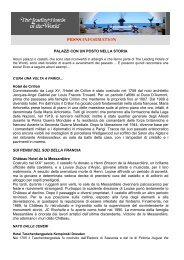You also want an ePaper? Increase the reach of your titles
YUMPU automatically turns print PDFs into web optimized ePapers that Google loves.
I t a l y – a n E m b a r r a s s m e n t o f R i c h e s<br />
castello del nero<br />
Castello del Nero traces its orig<strong>in</strong>s to the 12th century when it<br />
became the country residence of the Florent<strong>in</strong>e noble family<br />
whose coat of arms can still be seen, along <strong>with</strong> frescoes that<br />
were pa<strong>in</strong>ted dur<strong>in</strong>g various periods of the hotel’s history.<br />
Among its other dist<strong>in</strong>ctive features are a clock tower, three<br />
huge fireplaces, secret doors, passageways, and two different<br />
family crests. The private chapel, dedicated to San Michele and<br />
San Filippo Neri, was built <strong>in</strong> the late 1700s, at about the time<br />
that the mechanism <strong>in</strong> the clock tower was <strong>in</strong>stalled. After the<br />
Del Nero family l<strong>in</strong>e died out, the estate was taken over by the<br />
Torrigiani family. Carlo Torrigiani put great efforts <strong>in</strong>to<br />
<strong>in</strong>creas<strong>in</strong>g the activities of the estate farm, and his American<br />
wife Anna Frey, was so devoted to the Castello, that she<br />
requested to be buried <strong>in</strong> the chapel follow<strong>in</strong>g her death <strong>in</strong><br />
1917. In 2006, the property reopened as a hotel, and proudly<br />
displays a number of artifacts from the castle days: furniture,<br />
lamps, pa<strong>in</strong>t<strong>in</strong>gs, and a library of account<strong>in</strong>g registers from the<br />
18th century perta<strong>in</strong><strong>in</strong>g to the estate’s farm land.<br />
Hotel caruso<br />
The Hotel Caruso <strong>in</strong> Ravello was built <strong>in</strong> the 11th century by<br />
a patrician Roman family. The orig<strong>in</strong>al palace was largely<br />
destroyed by the Republic of Pisa, and lay deserted until the<br />
mid-1500s, when a period of reconstruction began. The present<br />
palace was completed <strong>in</strong> the 1600s. A further period of neglect<br />
followed, until 1893 when Pantaleone Caruso and his wife<br />
Emilia Cicalese, rented five rooms <strong>in</strong> one of the w<strong>in</strong>gs of the<br />
palace. They opened as the Pensione Belvedere, referenc<strong>in</strong>g the<br />
splendid view of the hang<strong>in</strong>g garden plung<strong>in</strong>g down the mounta<strong>in</strong>side<br />
to the sea. In 1903 a New York Times journalist visited,<br />
and his article <strong>in</strong>spired many wealthy Americans w<strong>in</strong>ter<strong>in</strong>g on<br />
the European Rivieras to visit. The hotel came to occupy the<br />
entire palazzo, and was renamed Hotel Caruso Belvedere.<br />
Dur<strong>in</strong>g Caruso’s restructur<strong>in</strong>g, traces of 18th-century frescoes<br />
were revealed, and the pa<strong>in</strong>t<strong>in</strong>gs were uncovered and restored.<br />
Of particular <strong>in</strong>terest is the ceil<strong>in</strong>g <strong>in</strong> the hall, which has a pair<br />
of griff<strong>in</strong>s fac<strong>in</strong>g each other, almost as if guard<strong>in</strong>g four frescoes<br />
depict<strong>in</strong>g Ravello. There is also a chapel, which has a stone altar<br />
<strong>in</strong> baroque style, pa<strong>in</strong>ted <strong>with</strong> a marbled tempera and decorated<br />
<strong>with</strong> a stucco relief. Both sides of the chapel above the<br />
altar have stucco relief carv<strong>in</strong>gs, <strong>with</strong> images of sa<strong>in</strong>ts <strong>in</strong> prayer.<br />
Grand Hotel cont<strong>in</strong>ental<br />
Built by orders of Pope Alexander VII <strong>in</strong> the 17th century for<br />
his niece on her marriage, Palazzo Gori Pannil<strong>in</strong>i <strong>in</strong> Siena<br />
evolved <strong>in</strong> the early 20th century to become a hotel called the<br />
Cont<strong>in</strong>ental, today – Grand Hotel Cont<strong>in</strong>ental. The majestic<br />
façade features a great portal crowned <strong>with</strong> the Gori coat of<br />
arms. In the hall, guests can admire the high frescoed ceil<strong>in</strong>gs<br />
of the palazzo, lit now <strong>with</strong> 18th-century style lantern-shaped<br />
lamps. The magnificent Salone delle Feste is frescoed throughout<br />
<strong>with</strong> monochromatic 18th-century trompe l’oeil decorations<br />
of pastoral landscapes and imag<strong>in</strong>ary architectural views,<br />
culm<strong>in</strong>at<strong>in</strong>g <strong>in</strong> the crest of the Gori Pannil<strong>in</strong>i family. Other<br />
po<strong>in</strong>ts of <strong>in</strong>terest <strong>in</strong>clude the two-room San Cristoforo suite<br />
featur<strong>in</strong>g a 15th-century wall pa<strong>in</strong>t<strong>in</strong>g of the Sienese school<br />
depict<strong>in</strong>g St. Christopher, which was discovered and restored<br />
dur<strong>in</strong>g the renovation work, while the five rooms overlook<strong>in</strong>g<br />
Via dei Term<strong>in</strong>i on the opposite side have ceil<strong>in</strong>gs decorated<br />
by the 18th-century Sienese pa<strong>in</strong>ter Giovanni Battista<br />
Marchetti.<br />
On THe sHOres Of THe bOspHOrUs<br />
ciragan palace<br />
The colorful past of the Ciragan Palace reaches back to the 17thcentury<br />
Kazancioglu Gardens which stretched from Besiktas to<br />
Ortakoy. The first waterside villa was built <strong>in</strong> these gardens <strong>in</strong><br />
1719 by Grand Vizier İbrahim Pasha of Nevşehir for his wife<br />
Fatma Sultan. In 1834, Sultan Mahmut II decided to tear<br />
down the villa and replace it <strong>with</strong> an entirely new palace. This<br />
structure was destroyed <strong>in</strong> 1857 by Sultan Abdülmecid <strong>in</strong> preparation<br />
for a yet another new palace, but he died <strong>in</strong> 1861<br />
<strong>with</strong>out complet<strong>in</strong>g the project. His brother, Sultan Abdülaziz,<br />
cont<strong>in</strong>ued his brother's dream of expansion, and the construction<br />
of the Ciragan Palace, which began <strong>in</strong> 1863, was completed<br />
<strong>in</strong> 1871. The Palace rema<strong>in</strong>ed a royal residence until the early<br />
1900s. In 1909, it was selected as the site for a meet<strong>in</strong>g of the<br />
Turkish Parliament. Shortly after the conclusion of the<br />
meet<strong>in</strong>g <strong>in</strong> January 1910, a fire started <strong>in</strong> the attic, and destroyed<br />
the <strong>in</strong>terior of the Palace <strong>in</strong>clud<strong>in</strong>g significant antiques,<br />
artworks and books. At the end of World War I, dur<strong>in</strong>g the<br />
occupation of Istanbul, the ru<strong>in</strong>ed Palace was used as “Bizo<br />
Barrack” by the French military field corps eng<strong>in</strong>eers. In 1987,<br />
restoration was begun, as was the construction of an adjacent<br />
hotel, which opened <strong>in</strong> 1990.<br />
VIlla d’eSte

















